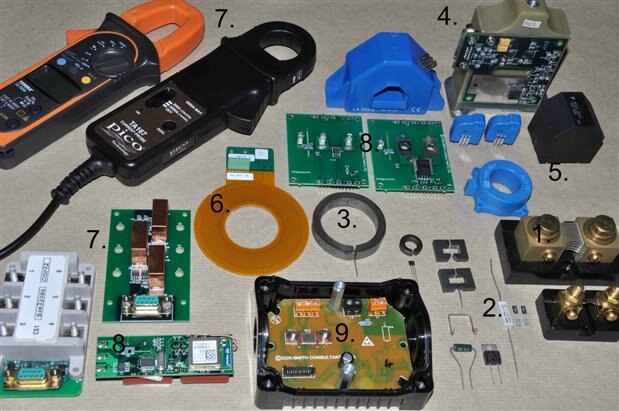Current Sensor 1. Introduction.
19 Feb 2015
Voltage and current sensing are fundamental to electrical and electronic circuits. Pretty much all analogue parametric sensors have a voltage output that is going to be compatible with the input of some measuring device, for example an ADC or the input to an amplifier. Current sensors must in some way convert the current to voltage for measurement and in general there are 2 methods, either a resistor is in the current path and the voltage across the resistor is measured, or the magnetic field around the current path is detected and converted to voltage for measurement. In the photograph at the heading of this blog both types of current sensor are represented.
Current sensing is required in a wide range of electrical and electronic applications. For example:
- Battery life indicators and chargers
- Over-current protection
- Current and voltage regulators
- Power supply controllers
- Current control in solenoids
- Motor torque control
- Heater controls
- And so on
The current may range from milliamps to thousands of amps, it may be DC or AC, it may be steady or transient.
Direct current sensing – resistive - invasive.
Direct resistive current sensing is based on Ohm’s Law, by placing a resistor (perhaps referred to as a current shunt) in series with a load, a voltage is generated that is proportional to the current. The voltage may be scaled by an amplifier before it is passed to the measurement circuit. The amplifier may be a specialist current shunt monitor, an operational amplifier, a difference amplifier or an instrumentation amplifier. This method of measurement is referred to as invasive, there is no galvanic isolation, as the current shunt resistor and measurement circuit are connected to the circuit whose parameters are being measured; so grounding and common mode voltage must be considered when such a measurement is made. If galvanic isolation is required with a current shunt then an isolation amplifier must be used. The current shunt resistor will dissipate heat as I2R and the value of R used will be determined by the allowed heating effect traded off with the sensing voltage range and the amplifier gain.
Indirect current sensing – magnetic field – isolated.
Indirect current sensing is based on Ampere’s and Faraday’s laws of magnetism. There are a number of configurations for the sensing element relative to the current carrying conductor. If a toroid magnetic material is wrapped around the conductor and a slot is cut in it, then the magnetic field in the resulting air gap is proportional to the current in the conductor. The magnetic field must be converted to a voltage in order to measure it and a Hall Effect sensor is often used. This type of sensor has no direct connection to the circuit that carries the current and is therefore isolated or non-invasive. In a variant of this method, the toroid may have a secondary coil wound onto it and a current passed through the coil such that it opposes the field of the conductor we wish to measure. In this case, a closed loop circuit sets the secondary current to achieve zero field in the air gap; the secondary current is proportional to the primary current and can be measured by a current shunt; galvanic isolation still exists between the primary and secondary circuits.
Current transformers work with AC current by winding a large number of turns onto the secondary of the transformer core and the primary is a single turn passing through the core. The current in the secondary is measured by generating a voltage across a resistor but galvanic isolation is maintained between the measurement and primary circuits.
A Rogowski current sensor is an air cored coil where the coil is wrapped around the conductor. The voltage output of such a coil is proportional to the rate of change of current so an integrator is used to generate a voltage for the measurement circuit.
Types of current sensor:
- Typical current shunt resistor, 200A generates 50mV output.
- Current measurement resistor, 0.05R.
- Toroid made of silicon steel with a Hall Sensor in an air gap.
- Closed loop Hall Sensor, the secondary coil is wound on a ferrite core and potted.
- Current Transformer
- Rogowski coil made on a PCB with integrator and amplifier.
- These sensors all use a toroid, air gap and Hall sensor.
- These sensors use a magnetic core and Hall sensor miniaturised into a package with an amplifier.
- 20A current shunt in a DC electrical meter.
Also available at https://electronicsknowhowblog.wordpress.com/


Top Comments
-

Former Member
-
Cancel
-
Vote Up
0
Vote Down
-
-
Sign in to reply
-
More
-
Cancel
Comment-

Former Member
-
Cancel
-
Vote Up
0
Vote Down
-
-
Sign in to reply
-
More
-
Cancel
Children